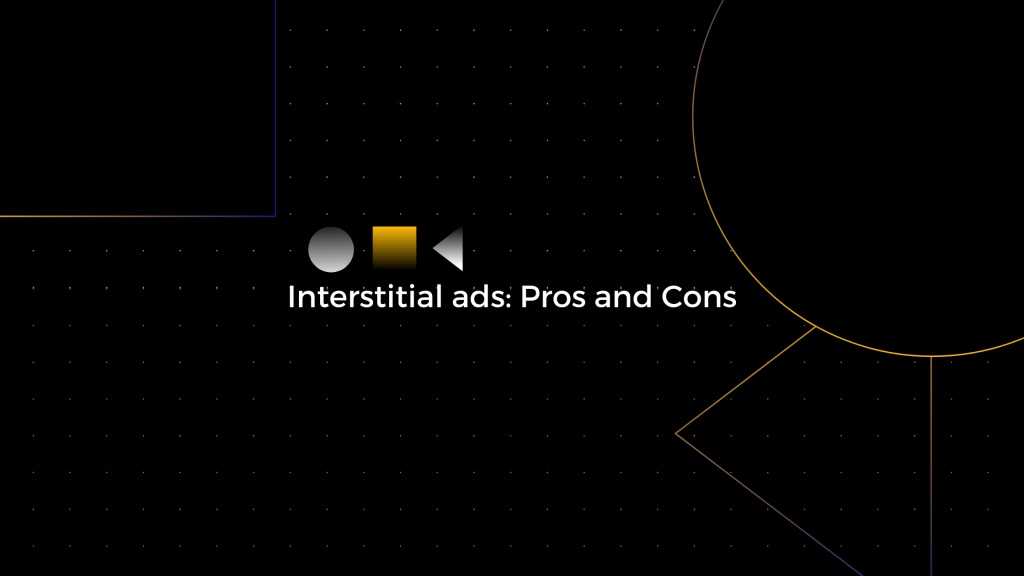Interstitial ads have become quite popular in the last few years, despite the penalties set by Google back in 2015. They are most popular on mobile and in gaming apps, however, in 2020 Google also launched interstitials for the web (check out this article for more information on them). Since then, the format has gained more traction and has its fans and critics. Let’s see what exactly are interstitial ads, what are their pros and cons and some best practices for their implementation.

What are interstitial ads?
Interstitials are essentially full-screen ads that can be displayed on desktop or mobile web, or in-app. Normally, they appear at transitions points (such as navigating away from a page or after pausing a game) to minimize intrusiveness. Interstitials can be a variety of types, including, but not limited to images, video, rich media, and text. They are characterized by high click-through and CPM rates. However, publishers need to use them in compliance with the Better Ads Standards, Google’s Search Standards, Google’s recommended implementations, and best practices in order to stay away from penalties.
A compulsory element of interstitial ads is having a clear exit/close button. Web interstitials also have a fixed frequency cap of one ad being shown to a user per hour per subdomain. Ads should be preloaded in order to avoid latency when being displayed to the user and to ensure a positive user experience.
Advantages
Let’s take a look at why this ad format is so popular among publishers.
High Viewability and User Engagement
The prominence of interstitial ads leads to viewability levels that cannot really be matched by banner ads. A full-screen ad is impossible to ignore and results in greater user engagement. An impact that is desired by advertisers and leads to the other advantages of the format below.
High CPM Rates
Interstitial ads by definition take up the entire user screen and cannot be missed or avoided. And this is something advertisers want and are willing to pay premium rates for. Banner blindness has become a real issue in digital advertising and interstitial ads are one sure-fire way to overcome it.
High Click-Through Rates
As interstitial ads cannot be missed by the user, the chances that he or she will click on the ad quickly go up. After all, users only have two options – click on the ad or click the exit button. High CTR means more conversions and therefore, more revenue for the publishers. Pretty enticing.
Disadvantages
Interstitials sound like a great ad format so far, but they do have some very significant caveats, too:
User Experience
Imagine you are looking for information at a certain website and ‘boom’ – a full-screen ad appears just before you’ve reached it. Most people will get annoyed. Even though interstitial ads must be placed at natural stopping points for the user, they still are an interruption of some sort. And nobody likes interruptions. Thus, user experience with interstitial ads is diminished, to put it mildly.
Penalties for Inappropriate Implementation
Another aspect that publishers should keep in mind is that interstitial ads implementation must be done very carefully and considering all of Google’s guidelines and recommendations. Otherwise, the risk of getting a penalty is very high.
While the use of interstitial ads depends on the publisher’s views about the importance of user experience, user retention, and revenue goals, there are some best practices that we recommend following if you decide to implement them. These should help steer you away from getting penalties or driving your users away.
Best Practices
Consider Your Users’ Experience
This is a general rule, but it is especially important with interstitials: always place ads with the user experience in mind. They must appear at natural transition points, before the break page or the ‘Next’ button. Placing ads after a ‘Next/Continue’ button is visible on the page may be surprising and cause accidental clicks.
Interstitial ads should not appear right after the user lands on the website or at page load, nor when he or she is focusing on a task (such as filling out a form, playing a game, reading content).
Furthermore, preloading the ad to minimize any latency is another good practice to avoid showing ads at unintended times due to carrier network issues, for example.
Set Proper Limits
Web interstitial ads are limited by Google to one per hour per user for any given subdomain. For app interstitials, you should avoid placing ads at every step or action the user takes. After all, you want to keep those users coming back, instead of getting them too annoyed to ever use your website or app again.
Consistent Clear Exit Buttons
The users shouldn’t need to look for the ‘Exit/Close’ button. It should be prominent enough to be seen straight away. The ad appearing out of nothing is annoying enough for the users to make them search for a ‘getaway’ button. The occasional accidental click won’t benefit you if you get penalized for it after.
Wrap up
Interstitial ads come with great viewability, high CPM, and click-through rates, but also have a big impact on user experience. They should be implemented with careful consideration and strictly following Google’s standards and recommendations in order to avoid any penalties. They might get to bring a solid part of your revenues if you maintain an overall good user experience for your audience.

